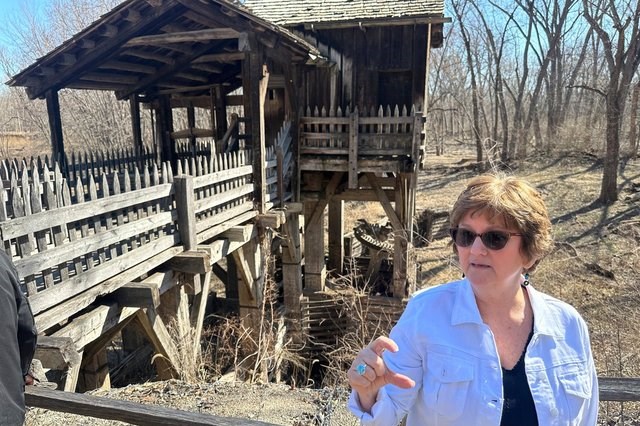
Gina Gillmore-Wolter, president of the New Salem Lincoln League, explains that the drive shaft, just over her right shoulder, has fallen out of the floor of the gristmill, part of the reconstructed village of New Salem where Abraham Lincoln lived from 1831 to 1837, March 10, 2025, in Petersburg, Ill. (AP Photo/John O'Connor)
Republished March 31, 2025 - 10:55 AM
Original Publication Date March 30, 2025 - 10:06 PM
PETERSBURG, Ill. (AP) — Before his famous debates, before the Civil War rent the nation, before he helped end slavery and before his tragic assassination, Abraham Lincoln had New Salem.
The tiny central Illinois village, where Lincoln accidentally spent half-a-dozen years in the 1830s, perhaps did as much to prepare him to be the Union-saving 16th president as any other aspect of his humble yet remarkable life.
Volunteers in period clothing provide historical demonstrations for hundreds of thousands of visitors each year at the site, now part of a state park over 200 miles (330 kilometers) southwest of Chicago. But long-neglected maintenance has taken a toll on the setting, which was re-created by a federal public works program in the 1930s during the Great Depression.
It took a dedicated volunteer and state lawmakers' advocacy this spring to secure state money to begin rehabbing the site. Work has not yet been scheduled.
What is New Salem's connection to Lincoln?
Lincoln, a clean-shaven 22-year-old with the barest of formal schooling, had set out in 1831 to haul freight down the Mississippi River to New Orleans when he snagged his flatboat on the Sangamon River dam at New Salem.
"That was destiny,” said Guy Fraker, a Bloomington, Illinois, lawyer and Lincoln biographer, “because if he hadn’t, I really firmly believe we’d be two countries.”
Lincoln freed the boat and continued to New Orleans, but returned to take up residence in the village just northwest of the capitol, Springfield.
In New Salem, Lincoln encountered the religious and the atheist, the learned and the illiterate. It's where he ran a store into bankruptcy, went off to war, served as postmaster, was offered a job as surveyor and thus taught himself geometry and by association, logic, began practicing law and lost his first political race but came back to win.
“This is where he got all of the education necessary to run for office, so this is probably the most important historic site in the state of Illinois, and certainly one of the most important historic sites in the country,” state Sen. Steve McClure said.
What's next for New Salem?
But some spots are off-limits. The drive shaft of the rebuilt gristmill fell out of the structure's floor following a 2016 flood. It's hard to get to it anyway because a pedestrian walkway over Illinois Route 97 is closed. A hole in the roof of the carding mill, used to straighten wool for spinning, grew this winter to the size of a refrigerator and half of the roof on the replicated Trent brothers' barn has collapsed.
Gina Gillmore-Wolter, president of the New Salem Lincoln League, roused McClure and another central Illinois Republican, state Rep. Wayne Rosenthal, to introduce legislation to appropriate money for rehabilitation and create a commission to oversee New Salem conservation.
McClure has put the brakes on the legislation because 10 days after Gillmore-Wolter and the lawmakers led a media tour of the village, the Illinois Department of Natural Resources, which oversees state historic sites, promised $8 million for repairs. It should be enough to stabilize structures and make some headway, but McClure said no one has inventoried problems or priced out remedies.
Natural Resources officials did not respond to emailed questions.
Why were improvements delayed?
New Salem withered shortly after Lincoln’s 1837 departure as residents picked up and moved when many transplanted their structures in the new county seat of Petersburg. Ironically, one of the best-preserved buildings is New Salem’s lone original: the Onstott Cooper Shop. Henry Onstott lent the auger Lincoln used to drain his swamped flatboat and ease it over the dam. The barrel-maker moved his shop to Petersburg in 1840, though it has since returned to its original spot.
By 1906, New Salem was a cow pasture with impressions marking erstwhile foundations. Media mogul and presidential hopeful William Randolph Hearst visited, then bought the property and donated it to the New Salem Chautauqua, an educational group.
It became a state park in 1918 and private donations paid for some reconstructed cabins, with many more added during the 1930s by the New Deal's Civilian Conservation Corps.
Budget shortfalls have hampered maintenance. Financial troubles closed all state parks for five months in the late 2000s. Advocates believe New Salem hasn't seen major improvements since the 1970s.
“This is Lincoln’s alma mater,” Gillmore-Wolter said. “This should be a priority.”
News from © The Associated Press, 2025